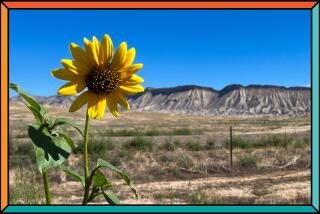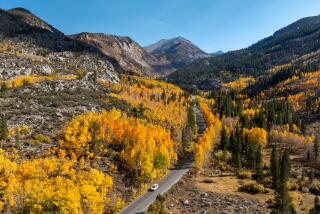Turning Over New Leaves : When the seasons change, New England gets most of the attention-and the crowds. Here are two less-traveled routes where fall colors are also spectacular. : Arizona
FLAGSTAFF, Ariz. — It was around the first of October last year when we headed northwest one morning out of Flagstaff, in the general direction of the Grand Canyon 75 miles away. We left the picturesque, 7,000-foot-high mountain town and drove toward the slopes and hidden valleys of the San Francisco Peaks--said to be splattered at that time of year with mind-boggling masses of gold.
Word had it that the aspens are at their best in late September and early October, when for a short season their cool, green, silver-dollar leaves turn to warm, sunny golds. Unlike the autumn of the East, the magic of this spectacle is momentary and capricious. One day the trees are ablaze (locals say the season is typically two weeks) and the next day, with a poof of wind, the yellow leaves are swept from the trees, gone until the next year’s performance.
We five--a friend from Whittier, my sister from San Dimas, another sister and her husband from Sedona, Ariz.--were full of anticipation as we drove along pine-shaded Arizona 180. But I was having trouble imagining the single color yellow making a display as spectacular as the golds and reds of New England’s fall foliage.
On the hillsides, small groves and single aspens titillated us by reflecting spots of light, but they were mostly camouflaged by the towering pine forests.
At some point--I’m not sure when--the light seemed magically to increase, and we realized we were in aspen country. There were more and more stately aspens, their white trunks topped with fluttering leaves ranging in color from canary yellow to a rich gold. Farther ahead, the slopes were covered by larger and larger patches of solid yellow, like melted butter or cooling molten gold.
I had begun to consider a change of opinion about one-color autumns, when we turned onto Harts Prairie Road, about 16 miles from the outskirts of Flagstaff. Wow! I brought my car to a quick halt as all five of us gasped in wonderment at what lay across the small meadow. New England had met its match.
Directly ahead against blue skies dotted with cotton-ball clouds was a massive woods of solid gold and white that emanated an ethereal golden glow. A narrow dirt road parted the golden curtain.
We drove slowly into the aura of golden light, the trees closing in overhead, and realized we were speaking in hushed tones although there wasn’t another car on the road as far as we could see in either direction. We parked the car close to one side, near the straight alabaster trunks of mature aspens, and walked quietly along the picture-perfect road, then in among the trees. There was little on the forest floor other than fallen twigs, leaves and an occasional young pine decorated with gold leaves as if for an early Christmas.
Wandering deeper into the woods we became aware that instead of subdued light and shade, the glow became brighter so that we could see far ahead and all about us. The golden leaves above us quivered with glinting sunlight as the breeze caught them, affirming their common name: quaking aspen.
We noticed the stark black marks made by bear on the snow-white bark and were told later that deer come out in the woods at sunset and bear at night.
Back on the road, we watched dollar-size aspen leaves dance on a gentle puff of breeze, becoming a gold bonanza as they glided to the roadside.
“Driving through the woods is wonderful, but you’ve got to get out of the car and get right in among them to really experience the feeling,” my sister, Faithe, finally commented in the stillness about us.
We had been told that the best aspen viewing in the area was along this crumbly dirt road (also known as Forest Service Road 151) that makes a right angle off Highway 180. We were told to look for a “Harts Prairie Road” sign on the highway about six miles out of Flagstaff, but to pass it up until we got to a second one about 10 miles farther. Watch your odometer and if you pass a large meadow, and then the Holy Dove Chapel on your right, you’ve gone too far.
Finding aspens may be easier than pinpointing their peak color time. My sister lives in Sedona, about half an hour’s drive from Flagstaff, so we had a spy in their midst. At the Flagstaff Visitors Center, service representative Laurel Wolfe explained that “the aspens change very quickly and are gone just as quickly, depending on the weather and temperature, when the first frost comes, how much rain we’ve had and how cold it gets at night.
“The leaves are at their prime for only about a week,” she said, generally during the last week in September and first week in October. “If we have enough moisture, they turn red-gold instead of canary yellow, as usually happens.” Wolfe urges potential visitors to call the center (800-842-7293) for leaf updates as the season approaches.
A sudden dust cloud disturbed our reverie and made us scramble to the side of the road as a car halted beside us. “Are you here to see the aspen?” a woman’s voice called from inside the car.
“Yes,” we said, commenting on their awesome beauty.
“You haven’t seen the best part,” she admonished. “I live here during the summer and spend my days driving and walking among the aspen. Follow me and I’ll show you where they’re best.” We thanked her and suggested she just give us directions, but after some insistence, we followed her dust about three miles farther in. She was right, we were in an even more magnificent grove.
Our self-appointed guide said she likes her privacy and preferred not to give us her name, but wanted to show us her cabin. We hesitated, but being an adventurous group we followed her dust again, this time to a side track that wound farther back into this golden land to her cabin.
We met her beautiful black dog, looked out her large picture windows--with their view of endless golden light and fluttering leaves--and were shown the four hot-water bottles she keeps in bed for warmth on early spring and late fall nights. We spotted her shotgun propped in the corner, and learned that she is a former teacher who chooses to live among the aspens in the summer, returning to the city to be with her husband and family in the fall. We were invited to come back next year.
Failing a handy cabin, you may camp anywhere among the aspens off Harts Prairie Road, according to Flagstaff Visitors Center manager Tim Rodriguez, but there are no fixed campgrounds, water or facilities.
There is a 44-site National Forest Service campground with water and restrooms near the Sunset Crater Visitor Center, about 10 miles above Flagstaff on Highway 89. (Highway 89 goes due north out of Flagstaff, while Highway 180 angles slightly northwest.) The campground fee is $7, and it is usually open from May to mid-October.
Two other favorite spots for aspen-watching in the area are Lockett Meadow and Snow Bowl, a ski area about 15 miles out of Flagstaff.
For Lockett Meadow, travel north on Highway 89 from Flagstaff about 10 miles. About five miles beyond the Sunset Crater turnoff (there’s a large sign on the right), turn left on Forest Service Road 552 (look for a small wooden sign) and follow signs for Lockett Meadow. The road is bumpy and slow going, but worth it. The aspens here surround the Inner Basin of the San Francisco Peaks.
For Snow Bowl, go north on Highway 180 about eight miles to the Fairfield Snow Bowl entrance; turn right on Snow Bowl Road and follow it seven miles to the Harts Prairie Lodge. At peak season, you’ll find a spectacular view of Harts Prairie covered with golden aspens. A skyride is open on weekends through October, weather permitting.
For those who can’t make it to see the aspens above Flagstaff, go late October to Thanksgiving to enjoy maple and oak trees as they turn to a pink gold in Oak Creek Canyon, located on 89A between Sedona and Flagstaff. Near Sedona, the maple trees are beautiful from the bridge at Slide Rock.
GUIDEBOOK
Finding Aspens in Arizona
Getting there: Delta, USAir and America West fly to Phoenix and Flagstaff from LAX. Round-trip to Phoenix with seven-day advance purchase is about $80; to Flagstaff about $160. Major car-rental agencies at both airports. From Phoenix to Flagstaff, take Interstate 17. From Sedona to Flagstaff, take 80A. Harts Prairie Road is about an hour’s drive from Sedona, 2 1/2-3 hours from Phoenix.
Harts Prairie Road: After aspen-viewing, take this road (also known as Forest Service Road 151) through the woods and back to Highway 180, turning left back to Flagstaff. To see “our favorite spot,” follow Harts Prairie Road about three miles in from the junction with Highway 180 to a fork in road. There, look for a small sign for Forest Service Road 418. Turn left about a quarter-mile and you are there. You may follow this road for about 15 miles to Highway 89. Turn right to return to Flagstaff.
Horseback rides: For rides into the Arizona wilderness, contact Eldon Bowman at Canyon Country Outfitters, Route 4, Box 739, Flagstaff 86001.
Where to stay: For information on Flagstaff lodgings (about $45-$120 per night), contact Flagstaff Visitors Center, 101 W. Santa Fe, Flagstaff 86001, (800) 842-7293; open Mon.-Sat. 8 a.m.-9 p.m., Sunday and holidays 8 a.m.-5 p.m.
For more information: Contact Coconino County National Forest Service, 2323 Greenlawn Lane, Flagstaff 86002, (602) 556-7400 or Arizona Office of Tourism, 1100 W. Washington St., Phoenix 85007, (602) 542-3618.
More to Read
Sign up for The Wild
We’ll help you find the best places to hike, bike and run, as well as the perfect silent spots for meditation and yoga.
You may occasionally receive promotional content from the Los Angeles Times.






